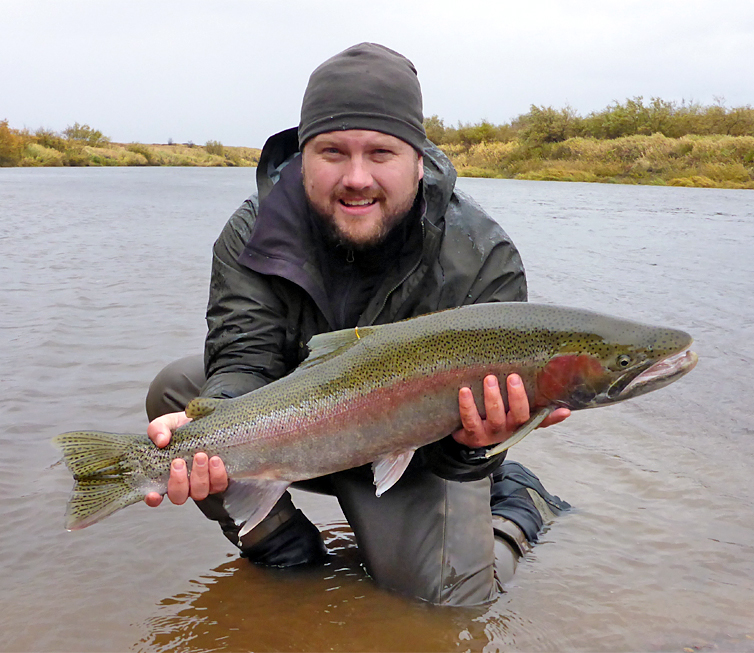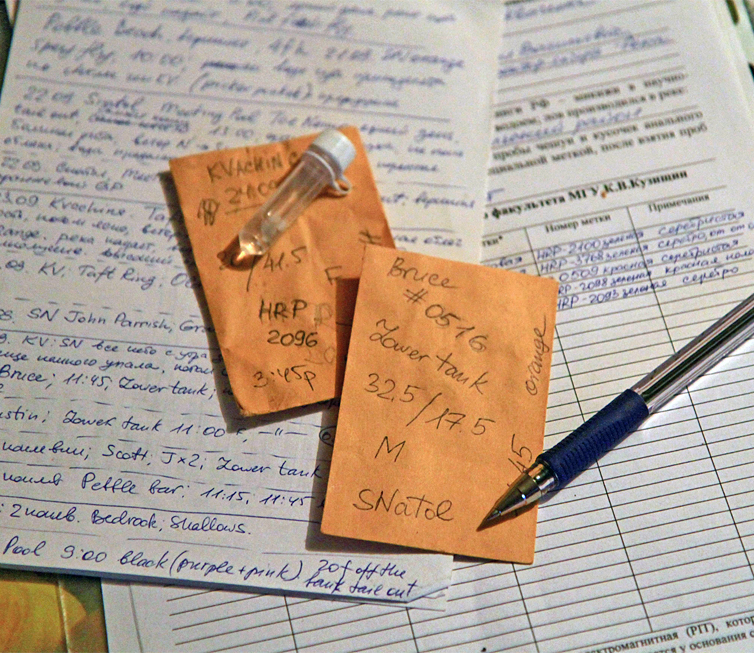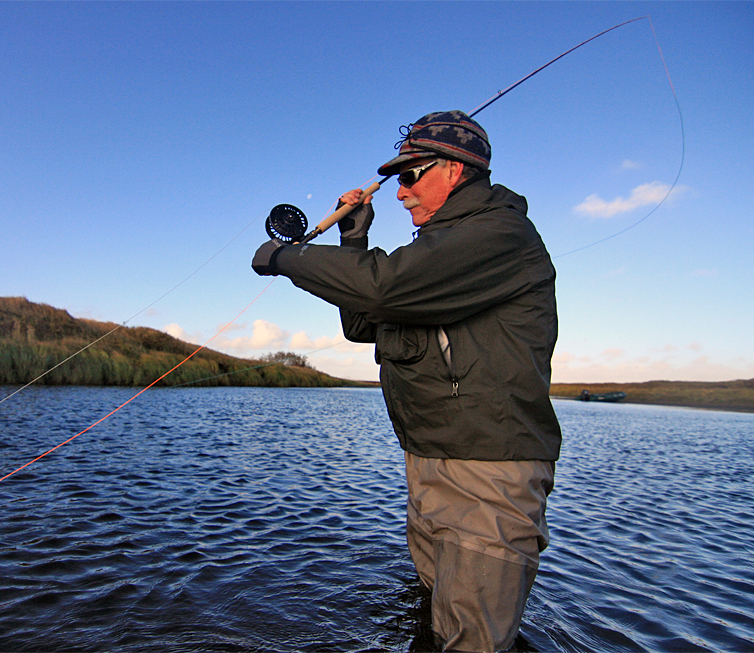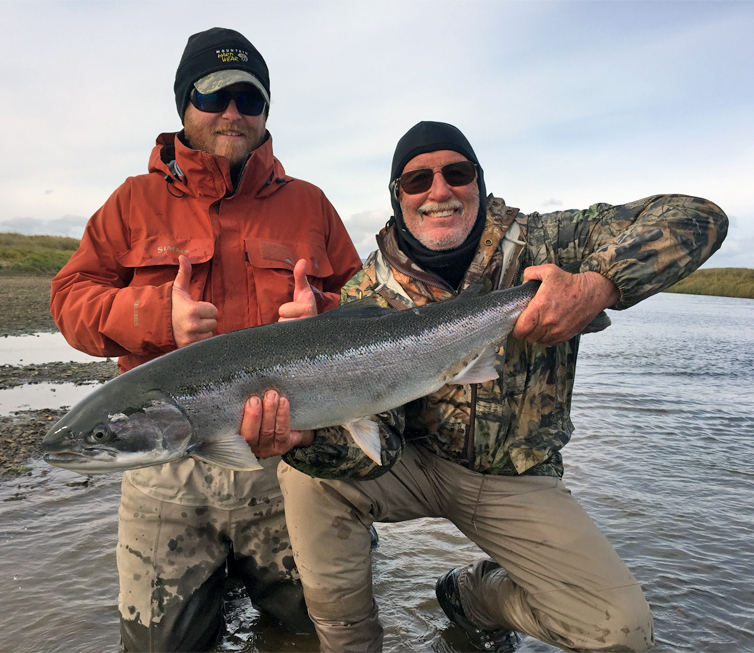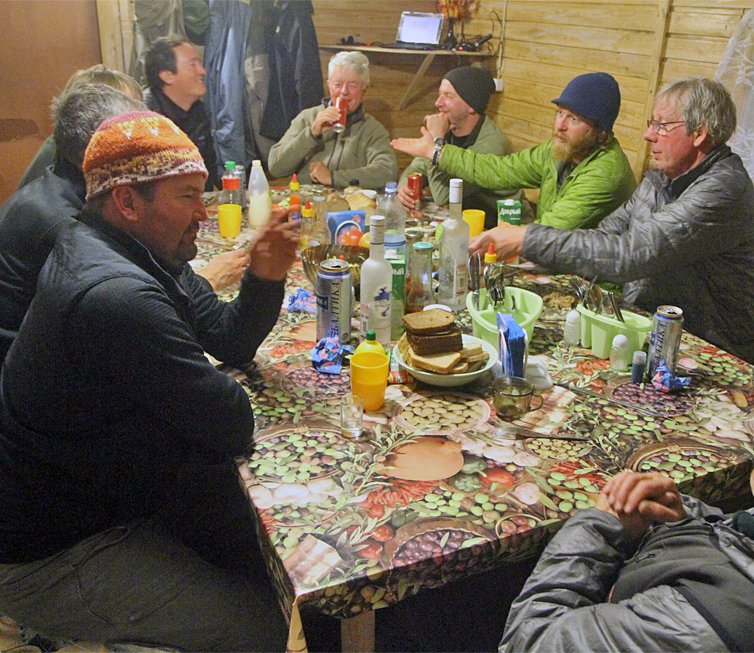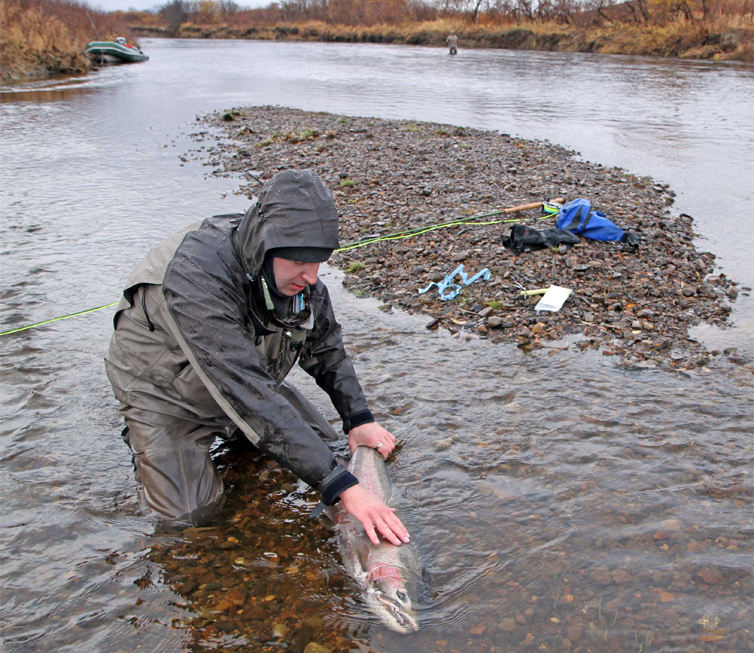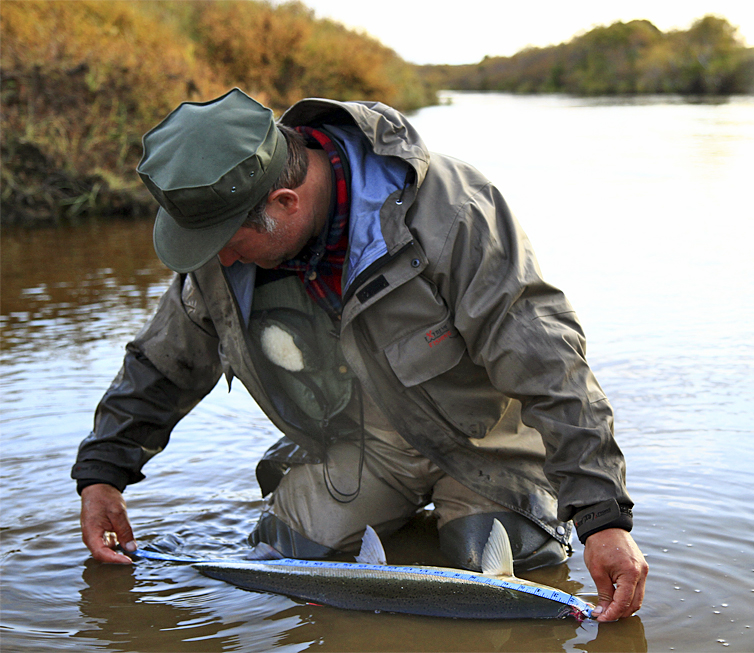Flyfishing for science… and the biggest, brightest steelhead that’ll ever grab your fly!
Kamchatka is home to Asia’s only population of the legendary steelhead, and the only way to legally target them is through a scientific research project… To participate you donate to the cause, then become a volunteer data collector with the job of trying to catch samples of the population, tag them, and then let them go unharmed. Not a bad job! And every cent you spend participating in Kamchatka Steelhead Project is fully tax deductible as a donation.
Steelhead are strictly protected under Russian law and spawn only in a handful of rivers draining westerly into Kamchatka’s Okhotsk Sea. Populations in three key rivers are very robust, and are the target of a unique Russian-American field project taking place each fall. Russian scientists, with the help and financial support of fly fishermen, work to monitor and ultimately protect a threatened race of strong, big-bodied steelhead in their isolated and completely pristine habitat. Through sponsorship of the Project, anglers fund the groundbreaking science and are in turn invited to join the expeditions as assistants to gather data on the fish – all of which are caught and released using traditional, non lethal fly fishing methods. For conservation-minded steelhead junkies with an extra ounce of adventure in their souls, there’s simply nothing comparable to traveling to the end of the Earth to feel the anvil-like headshake of a massive, fresh-from-the-sea, Russian steelhead that’s just grabbed your fly!
The Kamchatka Steelhead Project began in 1994 with funding from the US State Department and a charter under the US-Russian Agreement on the Environment. The KSP continues its mission today, offering something more important than merely an exotic fishing trip. This is a cultural and scientific exchange among like-minded anglers and scientists from both sides of the Pacific, whose common purpose is to understand and protect a creature with near-mythical strength and beauty.
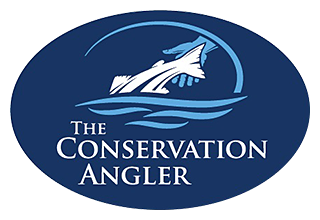 Today the Kamchatka Steelhead Project is jointly operated under the aegis of Moscow State University, the Russian Academy of Sciences, the Russian Federal Government, The Conservation Angler, and The Fly Shop®. Typically the Project organizes three 8 full fishing day expeditions taking place from the middle of September through the middle of October. Participating angler-sponsors assist Russian scientists in the collection of scale and tissue samples, and the tagging of all caught-and-released fish. This is more than a great fishing trip, it’s a worthwhile, accelerated learning course in sea-run fish at the elbow of experts.
Today the Kamchatka Steelhead Project is jointly operated under the aegis of Moscow State University, the Russian Academy of Sciences, the Russian Federal Government, The Conservation Angler, and The Fly Shop®. Typically the Project organizes three 8 full fishing day expeditions taking place from the middle of September through the middle of October. Participating angler-sponsors assist Russian scientists in the collection of scale and tissue samples, and the tagging of all caught-and-released fish. This is more than a great fishing trip, it’s a worthwhile, accelerated learning course in sea-run fish at the elbow of experts.
Through information collected from fly-caught steelhead during the life of the project, much has been brought to bear on our understanding not only of Asiatic steelhead but, by extension, their North American relatives. The edge of the sub-Arctic wilderness, and what it takes to get there, is not for everyone. But for those who are obsessed by the wild and the chrome, these rivers stand alone as a steelhead Mecca, in the purest, least impacted steelhead habitat left on the Earth.
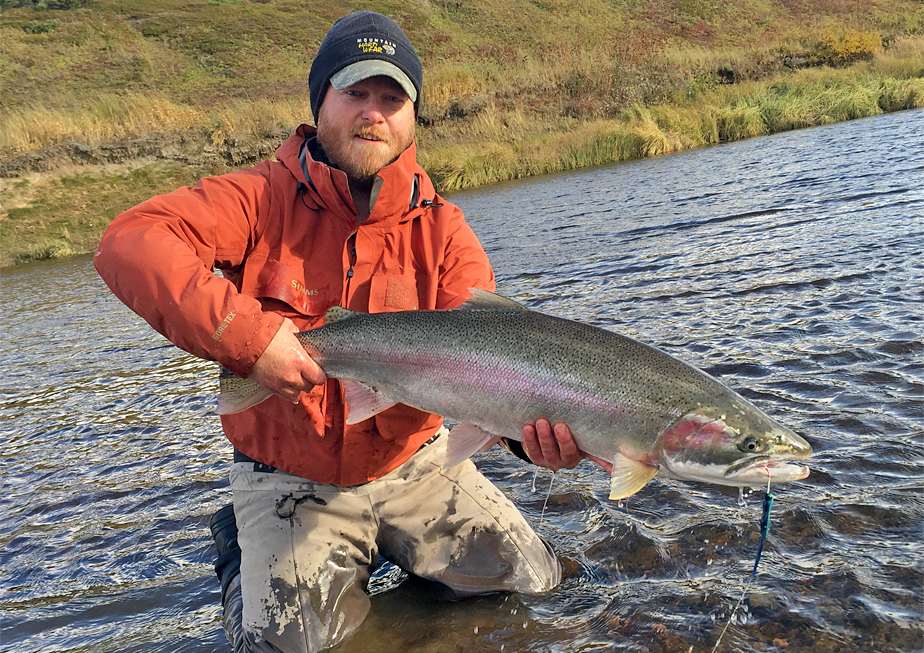
Reservations & Rates
11 nights/8 Full days of fishing: $9,995.00 USD per person
Available Dates:
• September 19 - 29, 2020
• September 28- October 8, 2020
• October 7 - 18, 2020
• Kamchatka, more than any destination in the world, attracts adventurous single anglers. There is no surcharge to come alone, we will pair you up with a great and equally enthusiastic steelhead fisher.
Inclusions
Included in your sponsorship package for the KSP is all ground and air transportation once in Kamchatka, and all food, accommodation and guides while in the field camp.
Non-Inclusions
Not included in your sponsorship package for the KSP are airfare and travel expenses from your home to Kamchatka, Russian visitor's visa, fishing gear, flies, medical evacuation insurance (required), hotels (if any) en route to Camp, and alcohol.
Travel Insurance
The Fly Shop® is not in the insurance business, but we recommend Travel Guard coverage as a service with a desire to see your best interests protected. It is impossible to know when an unfortunate situation (loss of luggage, fly rods, illness in the family, or an accident) may occur. However, such things can and do happen, and this insurance can provide a means of recourse against non-refundable financial losses.
• Travel Insurance Information
Seasons at Kamchatka Steelhead Project
Kamchatka steelhead are protected under Russia's Red Book of Rare and Disappearing species.
Like the Siberian Tiger or the sturgeon, Kamchatka steelhead are protected by law. No one may legally sportfish for or harvest them for any
Read More
purpose, without special permissions granted by the Russian federal government in the interest of science. They are protected not so much because they are disappearing, but rather because they are rare and only live in a handful of critical rivers. Their habitat is small but it is pristine, having been almost completely un-impacted by humans. For this reason our KSP field stations are the ideal place to study a species still interacting with its environment in the way Nature intended. It's a stunning opportunity to see steelheading like it used to be in the Pacific Northwest.
The spawning migration takes place in September and October, when water temperatures in the sea start to fall in relation to temperature in the river. While in some years good fishing can be had by September 5th, our expeditions coincide with the peak of the run, usually between September 13 and October 21. Like any sea-run fish, there are fewer in the river in the early part of the run (September) but they are more aggressive to the fly in the warm conditions. As temperatures fall through October, more fish pour into the river, however they are sometimes less aggressive to the fly. Historical catch records reflect that actual encounter rates and number of landed fish doesn't vary much over the field season.
The methods used to catch Kamchatka steelhead will be familiar to those used to catching them in British Columbia, Alaska and the Lower 48. By using a down-and-across swing method of fly presentation, we're able to solidly hook the fish, hopefully bring it to hand, take a sample of a few scales, tissue for DNA, and record its length, girth and sex. Finally, the fish is marked dorsally with a numbered tag so that if we catch it again, growth and life history data can be compared. One of the great advantages of using anglers to collect samples (as compared to old style methods of gill nets or seine nets) is that we can make our studies of the fish and then release them alive. No harm is done to the overall population.
For steelhead flyfishers, the thrills go far beyond the science side of the project. What any adventurer will take home from a visit to Kamchatka are indelible memories of steelhead that grow to an immense size, and the sheer power they exhibit when hooked, usually at or within a couple miles of tidewater.
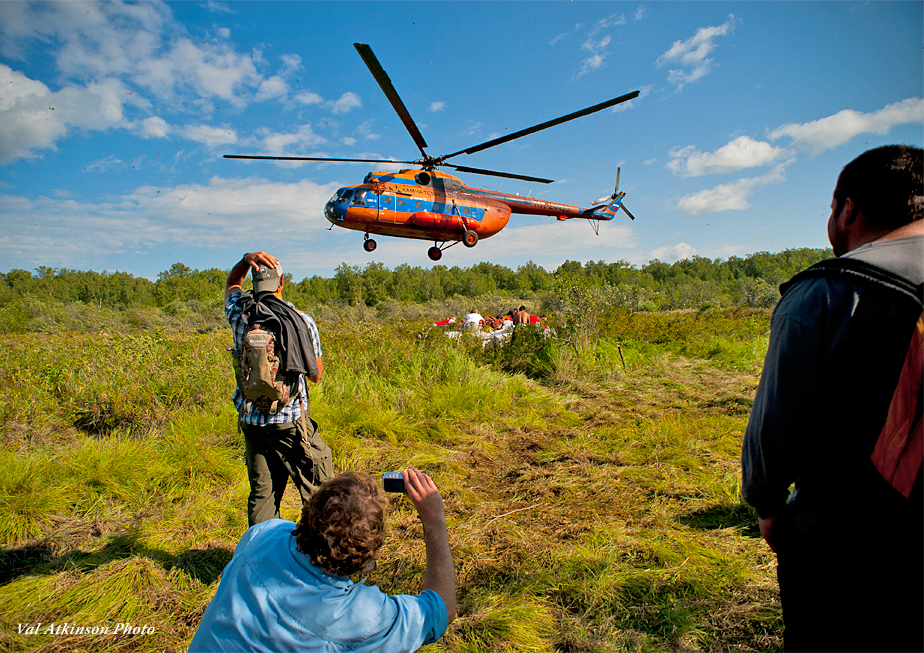
Getting to Kamchatka Steelhead Project
Kamchatka is possibly the most remote fishing area on Earth, and the KSP camps are located in the most remote part of Kamchatka.
Getting there in the late fall is normally accomplished by hopping an overnight direct flight to Moscow from one of several US points of departure, including Los Angeles, Houston, Chicago, Toronto, Atlanta, Washington DC or New York. From Moscow you connect directly to
Read More
Petropavlovsk-Kamchatka via a second overnight flight.
On arrival to Petropavlovsk you'll collect baggage and continue the journey to the interior heliport village of Esso. There you spend a well-earned night of rest. The following morning, weather permitting, you board a helicopter for camp.
As your river comes into view and the chopper descends for a landing, it's all you can do to contain the excitement long enough to get on waders and string up your rod.
At the end of the week your steps are reversed. One night is spent in PK before continuing to Moscow the following day. An overnight in Moscow is necessary to make safe international connections the following day and is easily accommodated at a convenient airport hotel.
Sample Itinerary:
Day 1: travel from home with an overnight flight to Moscow.
Day 2: arrive Moscow, connect to overnight flight to Kamchatka
Day 3: arrive Kamchatka, connect to village of Esso, overnight
Day 4: morning departure to camp, potentially a 1/2 day fishing
Days 5 - 12: 8 full days fishing for science
Day 13: depart camp, travel to Petropavlovsk, overnight
Day 14: depart Kamchatka, arrive Moscow, overnight
Day 15: depart Moscow, arrive home
For those who have the time, a 1-3 day tour of Moscow is a wonderful complement to your remote fishing trip. This gives opportunities for soaking in modern Russian culture, and for acclimatizing and catching your breath between long flights. Other possible routes to Kamchatka include transferring in Seoul, South Korea or Tokyo, Japan. There are also myriad options to connect to Moscow from major European cities.
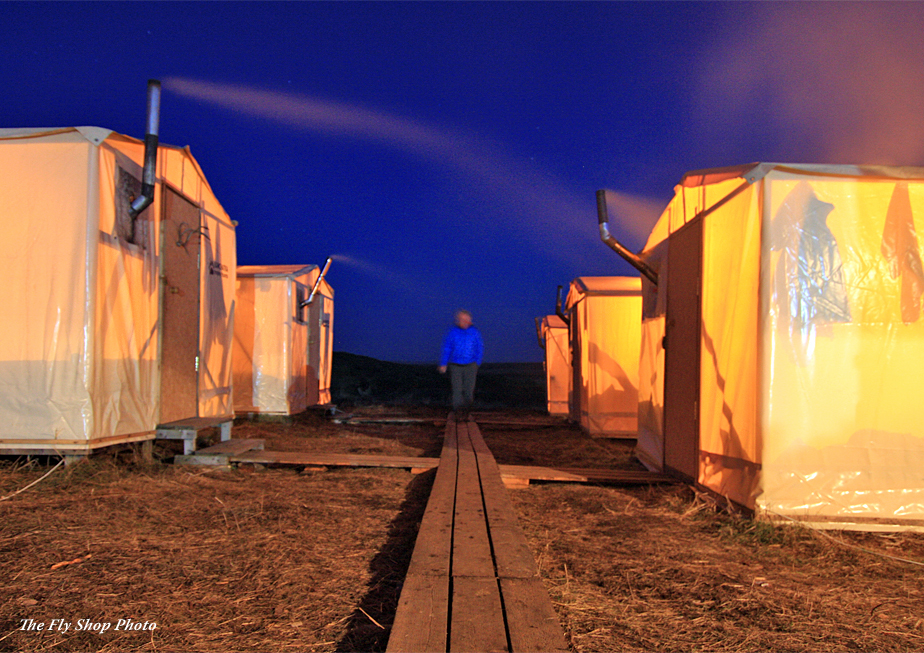
Lodging at Kamchatka Steelhead Project
Over the course of the 11 night / 8 day trip, 8 to 12 anglers are accommodated between 2 separate semi-permanent camps, erected on 2 different river systems, for the fall season.
Two anglers share a small canvas and wood-framed cabin similar to the weather-port cabins in use in many Alaskan camps. Each cabin has wood floors, a wood stove for heat, cots and mattresses. You must bring a
Read More
sleeping bag for this trip. There are flush toilet facilities, shower facilities with good water pressure and endless hot water, and a kitchen / dining room in a permanent wooden hunter's cabin.
The food in Kamchatka is tasty and plentiful, though certainly not gourmet. Fresh meats and locally grown, geothermal hot-house vegetables are the features of a cuisine not unfamiliar to the American palette. Delicious Russian soups like borscht are always the customary first course, and are always a hit with guests.
Beer and vodka is available for sale. Other or special libations must be purchased in the Duty Free shop en route to Russia, or else on arrival to Kamchatka.
It is important to understand the Kamchatka experience is much more rustic than an Alaska fly-out lodge. The focus of Kamchatka is most definitely on the fishing, yet the accommodations typically surprise our guests by how comfortable it is possible to be in such a remote environment.
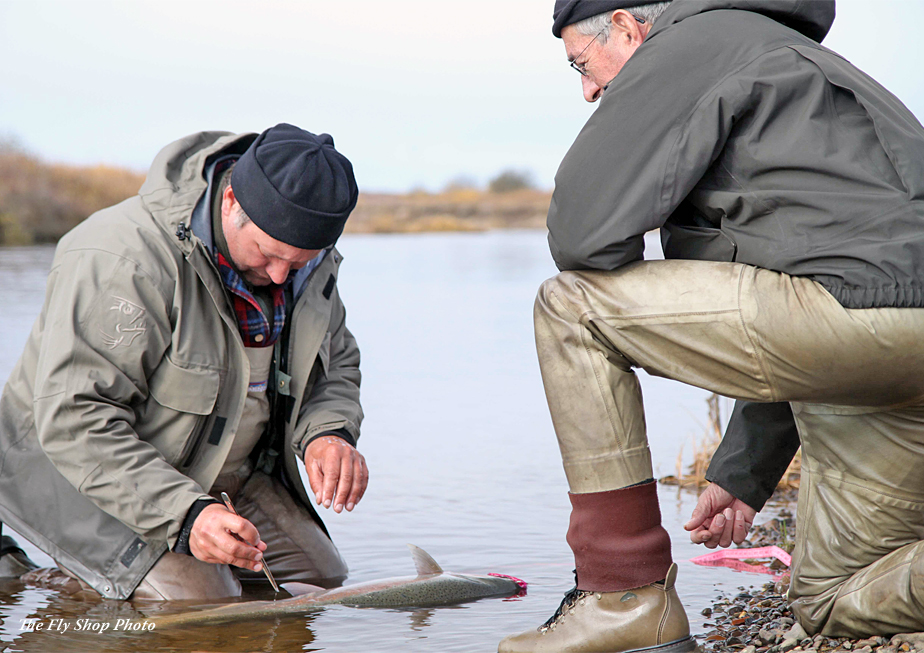
Fishing at Kamchatka Steelhead Project
The first day of your trip may allow for a bonus half-day of fishing. The last day will be to be ready for helicopter extraction home.
In between are 8 full fishing days of swinging flies that generally follow the schedule below. There is plenty of flexibility according to group preferences.
Read More
Sample Day:
7 am: coffee and tea
8 am: breakfast
9 am: on the water - Each two anglers are assigned a guide and an exclusive beat of the river.
1 pm: lunch served on the river. Hot soups on cold days, and sandwiches fruit veggies and other snacks, as well as water, coffee, tea and sodas.
6 pm: back to camp for showers and drinks
7 pm: dinner
8:15 pm: Cocktails, campfire and fish stories close out the day.
Depending on the camp you are in, Staff consists of one North American guide and another 1 or 3 Russian guides. A chief scientist will also be on hand to direct all studies. The cooks are professional and will surprise you with amazing meals everyday. There is also a camp Woodsman who takes care of all moving parts in camp, insuring the water is hot, the toilet flushes and the in cabin stoves are full of wood and hot while you are in camp. Other partner scientists may also be present.
All Kamchatka programs employ a guide rotation system, so each group of two anglers spends equal time with each guide.
Our North American guides are talented professionals with years of Russian and/or other international camp management experience, and years of prior experience guiding in Alaska, British Columbia or the Western US. They are selected not just for their significant on-water talents, but as curious, enthusiastic representatives of Kamchatka. Our Russian guides come from varied backgrounds, usually associated with biology, wildlife management, hunting, trapping or commercial fishing. Flyfishing being a relatively new sport to Russia, our guides come equipped with varying levels of pure flyfishing knowledge. Some are exceptional, having been with us for 10 or more years. Others have been brought on board for their skills as woodsmen and watermen, whose technical abilities are still evolving, but who are in rhythm with the lives and habits of of the rivers.
Why We Endorse This Destination:
Kamchatka Steelhead Project
• The rivers of the KSP boast the highest steelhead population densities on Earth. In a game where simply finding the fish is sometimes the hardest part, the equation here is simple: When there are a lot of steelhead in front of you, you have a higher success rate. This is NOT a fish of a thousand casts, this is what steelhead fishing should be like.
• The steelhead in these rivers have historically healthy populations. They are as good now as they have always been, with no significant declines in escapement numbers. Again, high numbers of fish equals higher catch rates than what most Steelheaders are accustomed too.
• These rivers are un-impacted by humans: no dams, no hatcheries, no deforestation, no grazing, no mining, no de-watering. This is why the populations are so strong. It is the only place on Earth where you can fish for fish almost totally uninfluenced by humankind. This is what it was like in the old days.
• KSP is an amazing opportunity to participate in an ongoing International scientific research project and learn more about steelhead. You will learn more participating in the KSP than any other fishing trip you have ever been on. That's good for the mind, and also good for the soul.
• This “trip” is actually a 100% Tax deductible donation to a scientific research project (for U.S. Citizens). You are a sponsor for the science, and the deduction makes the overall trip costs easier on the wallet. But just as important, you are helping scientists study and understand wild steelhead and that knowledge can help restore North American Steelhead populations and fisheries. By participating in the KSP, you are part of the solution.
• You will have multiple opportunities every day to hook giant, dime-bright steelhead, fish so fresh they still carry sea lice. It can be hard to actually find good places to target fish this fresh back home. Here it is the norm. And you have it all to yourself and a few other like-minded steelhead junkies. This is Steelhead Heaven!
• An outstanding team of guides and staff will make sure you are comfortable and fishing effectively, and most importantly having a good time! This is an opportunity to fish with steelhead-pros and the world's foremost scientist on steelhead. You will leave the KSP a better angler and a more informed anadromous fly fisherman, guaranteed.

